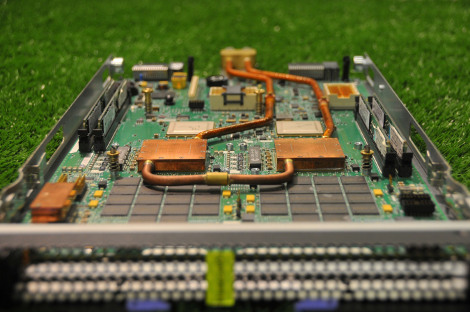Water-cooled IBM supercomputer to heat buildings

IBM and the Swiss Federal Institute of Technology at Zurich plan to build a water-cooled supercomputer whose surplus heat will be re-used to heat the university's buildings.
The Aquasar supercomputer will be located at the ETH Zurich facility, and it will start operations next year, the partners said in an announcement on Tuesday.
The supercomputer will combine two rack-mounted IBM BladeCenter servers, each containing multiple blades with a mixed population of IBM PowerXCell 8i and Intel Nehalem processors. It is expected to deliver a peak performance of about 10 teraflops.
The installation will re-use heat directly for in-building heating. IBM estimates that the watercooling scheme will reduce the system's carbon footprint by up to 85 percent and save up to 30 tons of CO2 annually, compared with standard cooling approaches. The comparison calculations are based on average yearly operation of the system and on in-building heating energy being produced by fossil fuels, the company said.
The energy-consuming refrigeration units used by almost every datacentre consume about half of the a datacentre's energy. Aquasar will need no such equipment. As a result, it should reduce overall energy consumption by 40 percent, according to IBM.
"Energy is arguably the number-one challenge humanity will be facing in the 21st century. We cannot afford anymore to design computer systems based on the criterion of computational speed and performance alone," Professor Poulikakos of ETH Zurich, the leader of the Aquasar project, said in a statement. "The new target must be high-performance and low-net power consumption supercomputers and datacentres. This means liquid cooling."
The system is the product of an extended joint research project between ETH and IBM scientists, focused on chip-level water-cooling. It also encompasses a concept for "water-cooled datacentres with direct energy re-use" proposed by scientists at IBM's Zurich Lab.
Aquasar's use of warm water rather than cold water for cooling is unique and IBM-patented, a spokesman for the company said. Water, which is about 4,000 times more efficient as a coolant than air, will enter the system at 60 degrees C. This will keep the chips in the system at operating temperatures below their maximum of 85 degrees C, according to IBM.
The high input temperature of the coolant results in an even higher-grade heat as an output, which in this case will be about 65 degrees C, the company said.
The system uses jet impingement cooling, which means that water makes direct contact with the back of the chip via micro-channels in the heatsink, according to research papers by the IBM and ETH scientists involved in the Aquasar project. "This method incurs neither the thermal resistance overhead of a base plate, nor the overhead and reliability problem of thermal interface materials, and thus is promising for removing highest-power densities," according to one paper.
Pipelines from the individual blades link to the server rack's waterpipe network, which in turn is connected to the main water transportation network. Aquasar will need about 10 litres of water for cooling, pumped at some 30 litres per minute, IBM said. The cooling system is a closed circuit: the water is heated by the chips and cooled to the required temperature as it passes through a passive heat exchanger, delivering the removed heat directly to the heating system of the university.
Aquasar will be used by the computer science department at ETH Zurich for multiscale flow simulations related to nanotechnology and fluid dynamics. Researchers plan to show that solving scientific problems efficiently can be performed in an energy-efficient manner.
